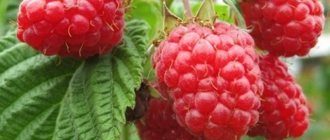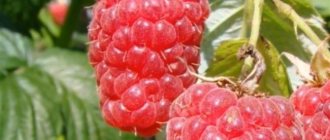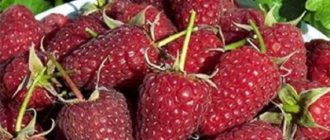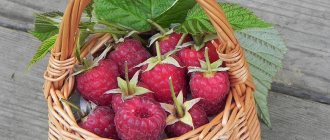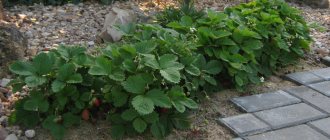Description of the variety
Remontant raspberry Eurasia is a medium-ripening crop with a wide range of berry applications. The main feature of remontant raspberries, in contrast to traditional varieties, is the fruiting of annual shoots. However, the variety can bear fruit on two-year-old stems, but this increases the load on the bushes and reduces productivity.
You might be interested! Description of a large-fruited, high-yielding variety that can withstand frosts below -30 degrees - raspberry Pride of Russia.
The bushes are compact, no more than 1.2-1.4 meters high, standard type, mostly upright, characterized by medium growth vigor, with a pronounced waxy coating and slight pubescence of the lateral fruit branches. Shoot formation is average. Young, annual shoots with a waxy coating have slight pubescence, but by the end of the growing season they acquire a dark purple hue.
Eurasia does not need gartering; therefore, there is no need to build trellises, which greatly simplifies caring for the crop.
The variety produces few replacement shoots, no more than 5-7. A small amount of root shoots was also noted; for this reason, the plantings were not thickened.
The thorniness is most pronounced in the lower part of the stems, but the upper part is moderately thorny. The spines at the bottom of the shoots are sharp, slightly curved down, and have a purple base.
The leaves of Eurasia are quite large, their shape is close to standard crimson, and they are green in color. The leaf blades are wrinkled, with barely noticeable curling.
The yield of the Eurasia variety is 134-140 c/ha or 2.6-2.8 kg. from the bush. The originators of the variety claim that if you follow the agricultural technology of planting and growing and favorable climatic conditions, you can harvest up to 5-6 kg. berries from the bush.
The variety is drought-resistant. Resistance to diseases and pests is quite high. However, in reviews, gardeners note that sometimes Eurasia can be affected by the witch’s broom virus.
Fruiting in Eurasia, like most remontant varieties, begins in early August. That is why the crop is perfect for growing in regions with harsh climates and short summers. The last harvest takes place in early to mid-September.
The variety is suitable for cultivation in any climatic conditions and is not demanding on soil composition. The peculiarity of the root system, which in Eurasia is closer to the taproot type, requires deep cultivation of the soil before planting.
Description of fruits
The berries of remontant raspberries Eurasia have a conical shape. The average weight of ripe berries varies between 3.6-4.5 grams, the largest specimens sometimes reach up to 6.5 g. The color is bright raspberry-burgundy, matte. Fruits in the full ripeness phase are of medium density and are easily separated from the stalk.
Eurasia tastes sweet and sour, with a faint raspberry aroma. In terms of taste, the berry is rated 3.9 points on a five-point system, which characterizes it as the variety most suitable for processing.
The sugar content in a ripe berry is about 7.1%, acids - approximately 1.75%, and vitamin C up to 35 mg. per 100 g.
Ripe fruits can hang on the bushes for up to a week. The quality and presentation do not change at all. Eurasian fruits tolerate transportation well.
Remontant raspberries Eurasia are suitable for consumption both fresh and processed. The berries retain their shape and taste well when deep frozen.
Raspberries "Eurasia" photos and reviews from gardeners
Many gardeners grow remontant raspberry varieties in their gardens, because such varieties usually produce a harvest in the first season after planting. In conditions of a long warm period, such raspberries are harvested before the beginning of autumn, and before the onset of frost, all shoots are simply cut off at ground level. And next season it all starts again.
And only in the conditions of the Urals or Siberia, where the summer is too short, are remontant raspberries grown in a two-year regime, covering all the bushes from freezing for the winter
.
The advantage of the remontant raspberry variety Eurasia is the ripening of the harvest already from the first ten days of August, therefore this berry bush is recommended to be grown in the conditions of Western and Eastern Siberia, in the Far East and the Urals as annual plants and at the same time to collect good harvests. Other advantages of this variety and the nuances of care will be discussed below.
The content of the article:
1. Description and main characteristics 2. Productivity of the Eurasia variety 3. Advantages and disadvantages of the variety 4. Features of caring for raspberries 4.1 Planting and propagation 4.2 Garter, fencing, pruning raspberry bushes 5. Reviews of those who grew Eurasia raspberries
Characteristics of the variety: pros and cons
The remontant raspberry variety Eurasia has a lot of advantages that increase its attractiveness not only for growing on personal plots, but also on large areas of farms:
- ease of care;
- the crop is not picky about the composition of the soil;
- can be grown in regions that do not have favorable climatic conditions;
- the variety is suitable for growing in large areas with mechanized harvesting;
- standard-type bushes have an attractive and decorative appearance;
- does not need a garter;
- high yield rates;
- large berries have an excellent presentation;
- the berries easily tolerate transportation, maintaining their taste and presentation for a long time;
- friendly, almost simultaneous ripening of berries;
- wide range of applications of raspberries;
- the risk of being affected by diseases and pests characteristic of this crop is quite low.
The only negative that is often found in reviews from gardeners is the taste of raspberries. However, the assessment of taste characteristics is rather individual in nature. No significant shortcomings were identified over such a long period.
Advantages and disadvantages
The advantages of the Eurasia variety include the following:
- Good productivity indicators (up to 2.6 kg),
- The dense structure of the fruits, which allows the harvest to be transported,
- Large berries
- Drought resistance
- The ability of ripened fruits to remain on the bush for a week, retaining all their qualities,
- Possibility of machine harvesting.
There are only two significant disadvantages: the low sugar content of the berries, the average level of resistance to pests and diseases.
Landing rules
It is advisable to plant Eurasia raspberries in early spring, before the beginning of the growing season. The appropriate time is approximately 7-10 days after the last spring frost.
In regions with a harsh climate, it is advisable to plant Eurasia raspberries on raised 40-50 cm and insulated beds. This planting method will ensure that the soil warms up earlier in the spring; shoots appear several weeks earlier. It has also been noted that in high beds the crop ripens faster.
For abundant fruiting, it is advisable to select a sufficiently lit area for planting raspberries, protected from piercing winds. Territories where meltwater stagnates are completely unsuitable for Eurasia.
A few days before planting, the future raspberry tree needs to be dug up. It is advisable to enrich the soil with humus (at least 20-25 kg per m² or 5-6 kg per planting hole) and wood ash. During the digging process, all roots and weeds are also carefully selected.
Raspberries can be planted in rows or in spots. The recommended planting pattern is as follows:
- the minimum distance between Eurasian seedlings is 70-80 cm;
- no more than 3-4 seedlings can be planted per 1 m²;
- The row spacing for trench planting should be 1.5-2 m.
The dimensions of planting holes or trenches depend on the size and condition of the root system. For large, well-developed roots, you need to dig larger holes, for small ones - smaller ones. The main thing is that the rhizomes are located freely in the hole.
The seedlings are placed in a trench or planting hole, covered and the soil is lightly compacted. After planting, Eurasia raspberries are watered and mulched abundantly.
Selection of seedlings
It is advisable to buy seedlings from a gardening nursery with a good reputation. You can also resort to the help of a large specialized online store. As a rule, they cooperate with specialized organizations and sell high-quality planting material, monitoring varietal purity.
Criteria for choosing a seedling:
- Planting material should be selected with a root system 20 cm long and with 3–4 buds at the base of the stem.
- The thickness of the shoot should not be less than 1 cm.
You should not pay attention to the length of the shoot, since it will still have to be trimmed before planting. But you should not purchase too large and lush seedlings, because they do not take root well in a new place.
More on the topic: Maroseyka raspberries
Before planting, you need to remove all leaves from the plant and cut off the ground part to a level of 30 cm. If there are dried areas on the roots, they should be removed. Then the seedling is placed in water for 6–8 hours so that it is saturated with moisture. If the plant was purchased long before planting, it should be buried.
Rules for caring for crops
The Eurasia raspberry variety is not demanding in care, grows well and bears fruit abundantly if the basic rules of agricultural technology are observed.
The crop should be watered as the top layer of soil dries. Raspberries love sprinkling, which can be done before flowering. When the first buds appear, it is advisable to abandon this method in favor of traditional furrow irrigation.
During periods of drought, raspberries need to be watered more often. It is also necessary to increase the rate and frequency of watering during the period of flowering, formation and ripening of berries. But after harvesting, you can moisten the soil in the raspberry garden no more than once a week.
Eurasia is fed at least 3-4 times during the season. The crop responds well to fertilizing with mullein infusion or bird droppings. Raspberries are fed with mineral or complex fertilizers on the basis that in the spring the plant is demanding of fertilizers containing nitrogen in order to quickly gain green mass, and in the fall raspberries need more potassium and phosphorus to gain strength and successfully winter.
Preparing Eurasia for winter consists of cleaning the raspberry trees, renewing the mulch layer and pruning the bushes, which is called “to zero”. Carrying out these measures will allow plants to withstand winter frosts without loss.
Mowing the shoots of remontant raspberries is recommended by experts and originators of the Eurasia variety, since this growing method provides many advantages:
- reducing labor costs for cleaning and pruning raspberries in early spring;
- The winter hardiness of the variety increases, since the need to bend and cover the shoots for the winter disappears;
- the risk of disease and insect pests is reduced tenfold;
- for the above-mentioned reason, the financial costs of treating raspberries from parasites and diseases are also reduced;
- Raspberries are ripening just at the time when the harvest of traditional varieties is already completed, and the demand for the berry increases sharply.
In general, Eurasia raspberries do not require close attention or special approach.
Harvesting and transportation
Since the quality of raspberries quickly declines after harvest, it is important to sell or process them on time. Maturity is determined by the fact that the berries acquire a uniform crimson color and are easily separated from the stem.
Important! The safety of raspberries depends on how well they have been cooled. At room temperature, the berries quickly become moldy.
Plan picking for the first half of the day and keep in mind that berries cannot be picked after rain - the weather must be dry. Harvest immediately in plastic containers or boxes with a volume of 250–400 g. The berries will be stored for no more than a week. During this time, they can either be eaten fresh, or prepared for the winter and preserved in one of many ways: in the form of compote, juice, jam and other methods. Freezing is also possible.
For transportation, the berries must be dense, evenly colored, without rot or damage. If you cut them together with a piece of the stalk, their shelf life will increase. Transporting such berries is also quite convenient: they spoil less during the trip. Containers with them are placed directly into a refrigerated vehicle to immediately go to their destination.
So, growing remontant raspberry varieties has many advantages. They are less susceptible to pest attacks, produce 2 harvests per year and are easy to maintain. By following simple rules for caring for plants, you are sure to get a good harvest of tasty and healthy berries
Reviews
Most reviews are devoted to the taste of fruits or yield, but I would like to write about an aspect that I have never seen in comments. My review is about survival. Of course, it’s good when the berries are large, sweet and there are a lot of them, but first of all it is necessary for the seedling to take root. But I just couldn’t achieve this. I planted seedlings several times, seemingly with a developed root system, seemingly according to all the canons, but the result was always the same - out of 10 pieces. Only 2-3 survived. I don’t know what I did wrong, maybe the seedlings themselves (I bought them delivered by mail) were already dry, I don’t know, it’s hard to judge. However, I also bought Eurasia with mail delivery and all of the 6 seedlings were accepted. And there were no differences in the planting of Eurasia from other varieties that never took root. So think about it, guess what’s the matter. Therefore, I can recommend the variety to people who want to get results with a high degree of probability. Otherwise, you know, seedlings are expensive, you, excuse me, you can say, you blow them in the ass, but there is no result.
I don’t like this variety, it has no flavor, so I make jam from it. There are a lot of berries growing, the variety is productive, so as I do, I use the Daughter of Hercules variety for food. But for conservation it’s Eurasia.
The Eurasia raspberry variety has many advantages, but gardeners are still arguing about its taste. These discussions are purely subjective. High yields, large fruits and ease of care more than compensate for this drawback. Maybe it is for this reason that Eurasia is quite popular.
Watering
Due to their shallow roots, Eurasia raspberries are sensitive to soil drying out. The Eurasia variety has sufficient drought resistance, but it is still better to provide the plants with moisture regularly, mainly in dry weather.
Raspberries are usually watered 6-7 times per season. Water for the first time when replacement shoots begin to sprout (usually in the last ten days of May), at the rate of 2 buckets per 1 meter of row.
In June - July, water at regular intervals 4 more times. In August, it is advisable not to water at all, unless there is intense and dry heat. By the end of September, moisture-recharging irrigation is carried out.
More on the topic: Ukrainian raspberry variety Autumn Syaivo
Possible diseases and pests
The resistance of the Eurasia variety to pests and diseases is assessed as average, since the crop can be attacked by viral and fungal diseases. To avoid unpleasant consequences, it is advisable to pay attention to preventive measures in a timely manner.
Table: raspberry diseases
| Diseases | Symptoms | Treatment methods | Prevention |
| Anthracnose |
|
|
|
| Chlorosis |
| Add organic matter every 2-3 years. |
|
| White spot |
|
|
|
| Ulcerative spotting | Brown spots appear on the stems, and cracks appear in the affected areas. | In early spring, use a 1% solution of the drug DNOC, treatment at the vegetative stage in case of severe damage with a solution of 50% Zineb 0.7% concentration. |
|
| Purple spot (didimella) |
| At the initial stage of bud break, treatment with 1% Bordeaux mixture. |
|
| Gray rot | Leaves and fruits are covered with a gray coating. | Before the leaves bloom, use the drug Hom (40 g per bucket of water). The solution needs to be treated with the bushes and the soil underneath them. | Loosening the soil under the plant. |




